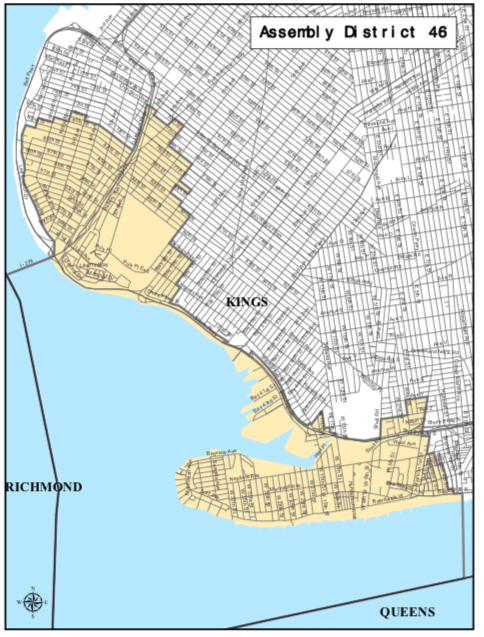Assembly District 46 Showdown: Mathylde Frontus vs. Ethan Lustig-Elgrably
8:01 AM EDT on September 6, 2018

We've been focusing on the State Senate, where insurgent candidates are running like never before, but our Assembly primary coverage continues today with the 46th Assembly District in Brooklyn — a rare open seat, thanks to the indictment of former Assemblywoman Pamela Harris. The candidates are: Mathylde Frontus and Ethan Lustig-Elgrably.
StreetsPAC endorsed Lustig-Elgrably, a former chief of staff to Council Member Mark Treyger, most likely because Frontus does not support congestion pricing.
Here are the candidates' answers, unedited, with a map of the district at the bottom of this post:
Do you support congestion pricing in New York City? If so, in what form? If not, why not?
FRONTUS: I do not support congestion pricing because working class New Yorkers are already struggling to make ends meet and it would not be fair to add an extra financial burden. I believe the issue should be studied further before a final decision is made. Of concern is the fact that may New Yorkers continue to live in communities with few public transit options. Those individuals should not be “penalized” so to speak for driving to work which would be a necessity. I should note that in recent months, neither the State Assembly nor State Senate could garner enough support for the idea of congestion pricing.
LUSTIG-ELGRABLY: Yes, I support congestion pricing as long as all revenue goes to improving the reliability and accessibility of public transit.
Subway ridership is down and New York's buses are slower than ever. What will you do in Albany/are doing in Albany to fix it?
FRONTUS: According to a report by the New York City Comptroller, the falling subway ridership is tied the Transit’s declining service. The bus system alone has lost 108 million passengers over the last eight years and that is due in no small part to the fact that our buses are among the slowest in the nation, among large cities. The study also found that declining bus service is due, in part, to the MTA’s failure to follow its own standards and schedules.
While the solutions for these problems will rest with the MTA (per any proposed plan, ie: the Comptroller’s nineteen recommendations; CEO Andy Byford’s Fast Forward Plan) it will require the assistance of the state legislature. My job as an Assemblywoman will be to work with my colleagues to provide aid to the MTA and also hold them accountable for taking measures to improve service which will in turn increase ridership. I will use my voice as an advocate to convey the urgency of these updates and repairs, especially as it pertains to the lack of accessible subway stations in my district.
Finally, the governing board of the MTA lacks gender and ethnic diversity, as well as representation from its patrons. It would be wise to diversity the board and include individuals who use the transit system on a regular basis so that their perspectives can be shared and integrated into the decision making.
LUSTIG-ELGRABLY: The bottom line is that we must make our public transit the best option for commuters and as it stands right now, the system doesn’t work for all New Yorkers the way it should. In my district, we need additional bus lines so that more residents can have access. I will advocate for infrastructure improvements to be prioritized over cosmetic changes.
MTA capital projects routinely cost five times as much as transit projects in other cities. How will you exert pressure on the MTA to control costs?
FRONTUS: In a recent report by the Regional Plan Association, the Chair of the board stated that the “MTA’s capital project delivery process is broken,” and that “projects take far too long, and cost way too much.” As a new Assembly member, I will work with my colleagues to research possible solutions to this problem and then work to hold the MTA accountable. There are many groups across the state studying this issue. The RPA for example, recently released 11 suggested reforms which could reduce project costs by 25 to 33 percent. While some of their suggestions I do not agree with, such as utilizing non-union laborers in order to reduce costs, others, such as creating realistic budgets and project timelines; engaging the public early and often; and streamlining the environmental review process, could be helpful.
Overall, as a State legislator, I will be uniquely positioned to hold the MTA accountable for its compliance or lack thereof, regarding compliance. I would also support legislation that would balance the budget and cap construction projects that are not completed in time.
LUSTIG-ELGRABLY: There needs to be more transparency and oversight so that we can properly hold MTA leadership accountable. I will work with my colleagues to impose strict deadlines and regular progress reports. Additionally, if a project is going to go over budget, the MTA should publish a formal report detailing the cost and reasons for the cost overrun.
How would you make streets in your district safer for walking and biking? Do you support the city's construction of protected bike lanes? If so, why? If not, why not?
FRONTUS: Pedestrian and bicycle safety are important issues in my district where accidents occur with some regularity. I would make the streets safer by focusing on two issues: speed safety cameras and protected bike lanes. Speed cameras are an effective tool for traffic safety as well as pedestrian related.
Given that the New York State Senate recently refused to extend the city’s speed camera program, it is critical that members of the Assembly use their voices to speak up and urge their colleagues to take this matter seriously. I fully support the city’s construction of protected bike lanes because they can help prevent traffic injuries.
LUSTIG-ELGRABLY: I believe that there are areas where protected bike lanes can work well and improve street safety. I believe that community input on the cost and benefits of proposed projects must play an integral role in decision making to ensure that these changes do not disrupt traffic flow and do not harm local businesses. The community must be consulted about these projects.
To specifically make the streets safer for walking and biking, I will advocate for implementing speed cameras, delayed green lights, better street lights, and designated walkways/bikeways.
What is the single biggest thing the state should do to get reckless drivers off New York City streets?
FRONTUS: I’m in support of the New York City Council’s Reckless Driver Accountability Act and believe that the New York State legislature should support this measure and pass similar legislation which flags motorists who are constantly speeding or violating the red light cameras. The legislation would allow their vehicles to be impounded after five or more infractions. This would serve as a major deterrent for those who are repeat offenders.
LUSTIG-ELGRABLY: We need our speed cameras to be turned back on so that reckless drivers can be punished for speeding in school zones. Our students should not be concerned about their safety when getting to school.
Is there a safety, design or enforcement strategy that is not being deployed that you think is vital to making our roadways, sidewalks and public spaces work better for everyone? (Hint: This is a "visionary" question, so don't think small.)
FRONTUS: I would like to see more open space and “urban plazas” in inner-city communities that are highly concentrated with tall buildings. It would be helpful to see a balance of the clustered space as well as open space where community members can sit down and talk to each other. This would be a design strategy and well worth pursuing in neighborhoods with significant overdevelopment taking place.
LUSTIG-ELGRABLY: We need to ensure that all drivers, cyclists, and walkers share space. In some European countries, they have implemented bike stop lights to help traffic flow, make cyclists more visible, and keep pedestrians safe.
In order to make bike riding more accessible for all New Yorkers, there should be steps taken to make bike share programs more affordable, specifically by creating tax credits for participating in bike share programs.
How often do you bike to the office (be honest)?
FRONTUS: I don’t bike at all.
LUSTIG-ELGRABLY: I live close enough to walk to my campaign office every day.
Gersh Kuntzman is editor in chief of Streetsblog NYC and Streetsblog USA. He also writes the Cycle of Rage column, which is archived here.
Stay in touch
Sign up for our free newsletter
More from Streetsblog New York City
Friday’s Headlines: Canal Street Follies Edition
Manhattan Borough President Mark Levine isn't happy. Plus other news.
Daylight Again: Bronx Community Board Backs Parking Ban at Intersections
The Boogie Down is down with daylighting!
Community Board Wants Protected Bike Lane on Empire Blvd.
Brooklyn Community Board 9 wants city to upgrade Empire Boulevard's frequently blocked bike lane, which serves as a gateway to Prospect Park.
The Brake: Why We Can’t End Violence on Transit With More Police
Are more cops the answer to violence against transit workers, or is it only driving societal tensions that make attacks more frequent?
Report: Road Violence Hits Record in First Quarter of 2024
Sixty people died in the first three months of the year, 50 percent more than the first quarter of 2018, which was the safest opening three months of any Vision Zero year.







